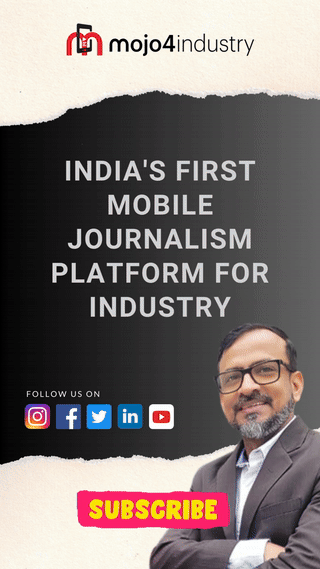Powering Precision: Unveiling the Secrets of Plasma Cutting Machines & Power Sources
WATCH this exclusive episode on plasma cutting for the manufacturing sector. If you’re in the manufacturing industry or have a keen interest in the fabrication world, this is an episode you won’t want to miss.
In this episode, you’ll delve into the fascinating world of plasma cutting – a vital technique in modern manufacturing processes. Industry leaders have shared insights, tips, and the latest advancements in plasma cutting machines and plasma cutting power sources.
Ravichandran Duraiswamy, AGM – Product Management, Messer Cutting Systems India, said: Thermal cutting involves the separation of plates, thin sheets, or thick plates, with a maximum thickness of 300 mm, using methods such as Oxyfuel, Plasma, and Laser Technologies. Oxyfuel cutting can handle up to 300 mm thickness, and sometimes even up to 600 mm. However, it is slow and requires a hole size of at least twice the plate thickness. Plasma cutting achieves a hole size equal to the plate thickness and can cut up to 160 mm. Laser cutting is suitable for materials up to 30-40 mm thick on stainless steel.
For optimal cutting within the 50mm to 60mm range, plasma cutting is the recommended choice due to its superior capabilities. Plasma offers advantages over Oxyfuel, providing better cut quality and wider material compatibility, including stainless steel, aluminum, and mild steel. Plasma also boasts higher productivity, up to 10 times faster than Oxyfuel, leading to lower cutting costs per unit.
Compared to laser cutting, plasma stands out with higher cutting speeds, resulting in greater productivity. Additionally, plasma requires lower capital investment and maintenance costs. Plasma is unique as it represents a fourth state of matter – ionized gas – used for cutting materials. There are limitations, such as unsuitability for underwater use and occasional challenges with achieving extremely fine cuts that lasers can provide.
Three types of Plasma Power Sources are available, including Air Plasma PMX, Oxygen Plasma Max Pro, and HY-Definition Plasma like XPR 170 and 300. The quality of cutting is influenced by factors like gantry rigidity, machine speed, acceleration, structural stability, and the precision of the height control system. The interplay between cutting speed, equipment movement, torch height, motor response, and drive performance significantly impacts the quality of the cut and the resulting material.
Balamurali Srinivasan, OEM Sales Manager- India, Hypertherm Associates, said: Let’s explore the development of plasma technology. In 1941, TIG welding was primarily used for joining parts. With some adjustments, it was adapted for cutting thin sheets, marking the start of non-conventional cutting methods. A significant advancement occurred in 1957 when Union Carbide’s Linde division introduced a plasma process capable of cutting heavy metals. This method used various gases for cutting and was prevalent until the 1970s.
In 1963, a notable improvement emerged: oxygen replaced nitrogen for cutting, boosting cutting speed by 25 percent. The year 1968 saw the establishment of Hypertherm. By the 1980s, Air Plasma gained significant traction in the market, leading to a 50-fold increase in plasma usage. Hypertherm, a leader in plasma technology since the mid-1980s, holds over 200 patents. We’ve innovated and reintroduced many concepts to the plasma industry, primarily focusing on addressing customer challenges, such as cutting costs and speed.
When inquired about the benefits of the synergy between Messer Cutting and Hypertherm, and how this collaborative strength positively impacts customers and, in broader terms, the manufacturing sector, Duraiswamy said, “Messer Cutting and Hypertherm have forged a deep and enduring partnership marked by collaborative development. Our history together is rich, and we continue to actively explore avenues for enhancing the plasma process, all to deliver optimal value to our customers.”
Speaking about the association, Balamurali said, “The collaboration between Hypertherm and Messer Cutting combines cutting-edge knowledge and technology in the realm of industrial cutting solutions. This partnership holds the promise of offering customers a range of innovative solutions and improved access to cutting-edge technologies. These technologies, including IoT-based solutions, are designed with a primary focus on addressing customer challenges. Our collective journey is geared towards eradicating pain points for customers, thereby enhancing productivity and minimizing operational bottlenecks.”
Balamurali further added, “Considering the challenges and insights shared by Mr. Ravichandran regarding various technologies, it becomes evident that plasma cutting is poised for significant growth, potentially doubling its current status. This growth aligns with emerging trends, especially within the expanding Indian economy characterized by robust construction activities. The increased demand for metal cutting in tandem with this growth underscores the need for advanced machinery.”
“As the landscape evolves, a strong emphasis on automation is palpable. The transition from manual operations to mechanized processes is gaining traction. This shift towards automation opens doors for us to provide valuable assistance. By facilitating this transition, we can play a pivotal role in shaping the landscape of industrial automation. These emerging trends indicate that plasma cutting is well-positioned for substantial growth in the coming years,” Balamurali shared.
“Our presence in the plasma market is challenging, especially as laser technology continues to advance rapidly. Similarly, we have been refining plasma technology, with Hypertherm leading to the development of the superior XPR 170 and 300 models, surpassing the previous HPR series. The industry is witnessing high demand and intense competition, often driven by laser solutions. We have taken proactive steps to cater to this demanding market. Our efforts include enhancing value through innovations like bevel-cutting and pipe-cutting functionalities. These technologies are integrated into our machines to ensure we deliver optimal solutions to our valued customers,” Duraiswamy concluded.






